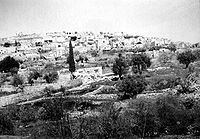Arabic قالونيا Population 1,056 (1948) | Palestine grid 165/133 | |
 | ||
Also spelled Qaluniya, Colonia, Kolonia | ||
Qalunya (Arabic: قالونيا, also transliterated Qaluniya, Colonia and Kolonia) was a Palestinian Arab village located 6 kilometers (3.7 mi) west of Jerusalem.
Contents
- History of qalunya as told on zochrot s tour
- Location
- History
- Ottoman era
- British Mandate era
- 1948 and after
- References
Prior to the village's destruction in 1948, with the exception of 166 dunams, Qalunya's land was privately owned: 3,594 dunams were owned by Arabs, while 1,084 dunams were owned by Jews.
History of qalunya as told on zochrot s tour
Location
Qalunya stood on a mountain slope, facing southwest; Wadi Qalunya passed through its eastern edge. The village lay on the Jerusalem-Jaffa highway, and a dirt path linked it to its neighboring villages. Qalunya was located near the Jewish town of Motza. Motza is now an outlying neighborhood of Jerusalem, and ruins of demolished buildings from Qalunya are present near Motza, covered in vegetation, just off the main highway between Jerusalem and Tel Aviv.
History
Qalunya is identified with the Canaanite town of Mozah (Joshua 18:26), its name was found stamped on pottery handles in Tall al-Nasba. during First and Second Temple periods Mozah was a Jewish village known for its willows that were used at the Temple of Jerusalem, the village was destroyed in the First Jewish–Roman War. After A.D. 71 Vespasian settled 800 Roman soldiers in the town, which became a Roman settlement known as Colonia Amosa or Colonia Emmaus. It has also been suggested that Qalunya was Emmaus.
The word colonia produced the Byzantine name, Koloneia, for the site. The status of the site in the early Islamic period has not been established, but the name was preserved in Crusader times as Qalonie or Qalunia and in Arabic as Qalunya. Mujir al-Din al-Hanbali reported that in 1192 it was a village near Jerusalem.
Ottoman era
In 1596, Qalunya was a village in the Ottoman Empire, nahiya (subdistrict) of Jerusalem under the liwa' (district) of Jerusalem, and it had a population of 110. It paid taxes on a number of crops, including wheat, barley and olives, as well as on goats, beehives and molasses.
In 1863 Victor Guérin found it to be a village of 500 inhabitants, while an Ottoman village list from about 1870 found that kalonije had a population of 120, in 43 houses, though the population count included men, only.
In 1883, the Palestine Exploration Fund's Survey of Western Palestine (SWP) described Qalunya as being a moderate-sized village perched on the slope of a hill, 300 feet (91 m) above a valley. Travelers reported that it had a "modern" restaurant. The villagers tended orange and lemon trees that were planted around a spring in the valley. To the west of the restaurant were ruins, possible of Byzantine origin.
In the 1890s, Jews purchased some of Qalunya's farmlands, and established the village of Motza, the first Jewish settlement outside Jerusalem.
British Mandate era
In the 1922 census of Palestine, conducted by the British Mandate authorities, Qalunieh (Qalonia) had a population 549; 456 Muslims, 88 Jews and 5 Orthodox Christians, increasing in the 1931 census to 632, 632 Muslims and 10 Christians; in a total of 156 houses.
During the 1929 Palestine riots, several residents of Qalunya attacked an outlying house in Motza belonging to the Maklef family, killing the father, mother, son, two daughters, and their two guests. Three children survived by escaping out a second-story window; one, Mordechai Maklef, later became Chief of Staff of the Israeli Army. The attackers included the lone police officer and armed man in the area, as well as a shepherd employed by the Maklef family. The village was subsequently abandoned by Jews for a year's time.
In 1945, Qalunya had a population of 900 Muslims and 10 Christians, while Motza had a population of 350 Jews. The total land area was 4,844 dunams. A total of 1,224 dunums of land were irrigated or used for plantations, 955 were used for cereals; while 227 dunams were classified as built-up areas.
1948, and after
On 11 April 1948, as part of Operation Nachshon, Hagana forces entered the village and blew up 50 houses. According to Ilan Pappe, Qalunya was one of four villages that were systematically destroyed by Hagana units in this fashion in the immediate wake of the Deir Yassin massacre; the others being, Beit Surik, Biddu and Saris.
